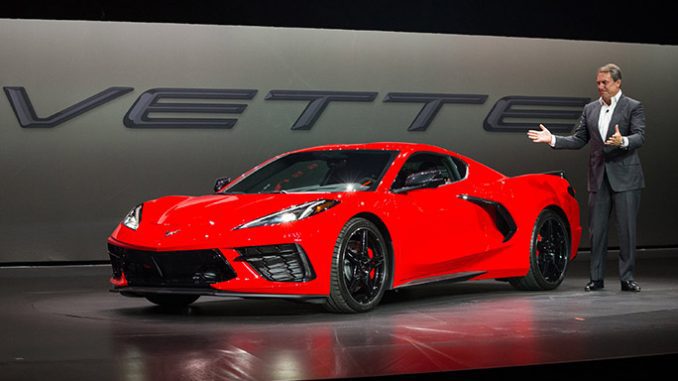
ORANGE COUNTY, Calif. — The 2020 Corvette, with a rear-mid-engine layout that has been rumored for nigh-on half a decade, is finally here. Unveiled in front of hundreds of journalists, owners, dealers and other VIPs in a disused World War II former blimp hangar in Tustin, Calif., the new C8 Corvette looks … exactly like what millions of spy shots have suggested.
There are only so many ways to draw a mid-engined sports car, but to my eye it looks like an Aventador made love to a McLaren with a little bit of the new NSX thrown in for good measure. As with every new sports car, aerodynamics take a front seat, with side air intakes for engine cooling and air pass-through ports below the rear taillights.
Of course, Chevrolet knows that Corvette purists will wail about the fact that the engine isn’t at the front. To assuage those fears, company execs spent quite a bit of time during the unveiling talking about how the C7 Corvette was the pinnacle of what a front-engined sports car could be, and it was time to move forward.
“This is the right time to move to mid-engine,” explained Tadge Juechter, the chief engineer of the new Corvette. “We’ve known for quite a while that we were reaching the end of what front engine could do.” Chevy claims the new entry-level Stingray can best 0-60 mph in under three seconds, faster than every Corvette with the exception of the fastest prior-generation C7.
Tucked behind the driver is a naturally aspirated 6.2-litre small block V8 engine called the LT2. Producing 495 horsepower at 6,450 rpm and 470 pound-feet of torque at 5,150 rpm (both ratings are with the optional performance exhaust), the LT2 is the most powerful entry-level Corvette ever released. Juechter says the Corvette will be the only remaining naturally aspirated V8 in the segment, with the company “bucking the trend” of forced induction.
An eight-speed dual-clutch transmission (with flappy paddles and manual mode) gets the power to the rear wheels which means that, in another blow to Corvette purists, the manual transmission is gone for good. A plethora of drive modes allow for customizing things, while a brand-new Z-Mode — complete with a Z button on the steering wheel — allows drivers to activate a fully customizable performance mode with a single press.
Twelve exterior colors (the white looked the best of the three they showed off at the launch), six interior themes, six seat belt colors, three different seat types, and three options for stitching mean there are plenty of ways to customize your Vette, too.
It also has sufficient storage behind the engine for two golf bags or to store the removable hardtop, and there’s a standard front trunk as well.
The interior is a little more questionable, with a long, long row of buttons running to the right of the center tunnel between the driver and passenger. We’ll have to test it in person to see if it’s as odd to use as it looks, but it drew more than a few inquisitive glances from the assembled press.
Perhaps the biggest question going into the event was pricing. Chevrolet, of course, didn’t lay out everything — that’ll come closer to the start of production later this year — but GM President Mark Reuss did reveal that the Stingray will start below $60,000, which is deeply impressive, though we’ll reserve our judgment until we see the full price sheet.

